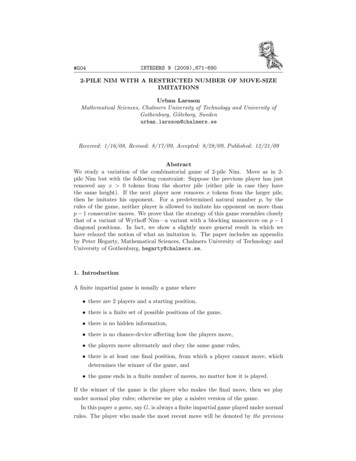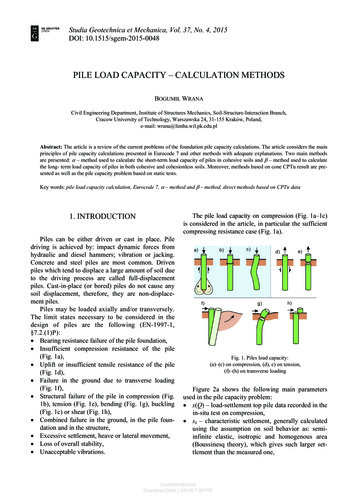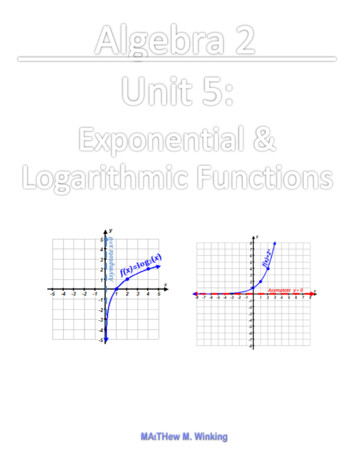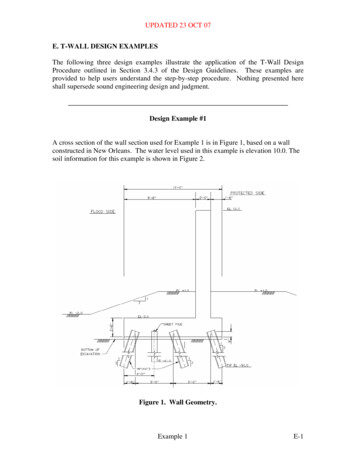
Transcription
#G04INTEGERS 9 (2009),671-6902-PILE NIM WITH A RESTRICTED NUMBER OF MOVE-SIZEIMITATIONSUrban LarssonMathematical Sciences, Chalmers University of Technology and University ofGothenburg, Göteborg, Swedenurban.larsson@chalmers.seReceived: 1/16/08, Revised: 8/17/09, Accepted: 8/28/09, Published: 12/21/09AbstractWe study a variation of the combinatorial game of 2-pile Nim. Move as in 2pile Nim but with the following constraint: Suppose the previous player has justremoved say x 0 tokens from the shorter pile (either pile in case they havethe same height). If the next player now removes x tokens from the larger pile,then he imitates his opponent. For a predetermined natural number p, by therules of the game, neither player is allowed to imitate his opponent on more thanp 1 consecutive moves. We prove that the strategy of this game resembles closelythat of a variant of Wythoff Nim—a variant with a blocking manoeuvre on p 1diagonal positions. In fact, we show a slightly more general result in which wehave relaxed the notion of what an imitation is. The paper includes an appendixby Peter Hegarty, Mathematical Sciences, Chalmers University of Technology andUniversity of Gothenburg, hegarty@chalmers.se.1. IntroductionA finite impartial game is usually a game where there are 2 players and a starting position, there is a finite set of possible positions of the game, there is no hidden information, there is no chance-device affecting how the players move, the players move alternately and obey the same game rules, there is at least one final position, from which a player cannot move, whichdetermines the winner of the game, and the game ends in a finite number of moves, no matter how it is played.If the winner of the game is the player who makes the final move, then we playunder normal play rules; otherwise we play a misère version of the game.In this paper a game, say G, is always a finite impartial game played under normalrules. The player who made the most recent move will be denoted by the previous
672INTEGERS: 9 (2009)player. A position from which the previous player will win, given best play, is calleda P -position, or just P . A position from which the next player will win is called anN -position, or just N . The set of all P -positions will be denoted by P P(G) andthe set of all N -positions by N N (G).Suppose A and B are the two piles of a 2-pile take-away game, which containa 0 and b 0 tokens respectively. Then the position is (a, b) and a move (or anoption) is denoted by (a, b) (c, d), where a c 0 and b d 0 but not botha c and b d. All our games are symmetric in the sense that (a, b) is P if andonly if (b, a) is P . Hence, to simplify notation, when we say (a, b) is P (N ) we alsomean (b, a) is P (N ). Throughout this paper, we let N0 denote the non-negativeintegers and N the positive integers.1.1. The Game of NimThe classical game of Nim is played on a finite number of piles, each containing anon-negative finite number of tokens, where the players alternately remove tokensfrom precisely one of the non-empty piles—that is, at least one token and at mostthe entire pile—until all piles are gone. The winning strategy of Nim is, wheneverpossible, to move so that the “Nim-sum” of the pile-heights equals zero, see forexample [4] or [22, page 3]. When played on one single pile there are only nextplayer winning positions except when the pile is empty. When played on two piles,the pile-heights should be equal to ensure victory for the previous player.1.2. Adjoin the P-positions as MovesA possible extension of a game is (!) to adjoin the P -positions of the original game asmoves in the new game. Clearly this will alter the P -positions of the original game.Indeed, if we adjoin the P -positions of 2-pile Nim as moves, then we get anotherfamous game, namely Wythoff Nim (a.k.a. Corner the Queen), see [25]. The set ofmoves are: Remove any number of tokens from one of the piles, or remove the samenumber of tokens from both piles.The P -positions of this game are well-known. Let φ ratio. Then (x, y) is a P -position if and only if(x, y) 1 52denote the golden!"# %nφ&, %nφ2 & n N0 .We will, in a generalized form, return to the nice arithmetic properties of this andother sequences in Proposition 14 (see also [13] for further generalizations).Other examples of (!) are the Wythoff-extensions of n-pile Nim for n 3 discussed in [3, 8, 23, 24] as well as some extensions to the game of 2-pile Wythoff Nimin [9], where the authors adjoin subsets of the Wythoff Nim P -positions as movesin new games.
673INTEGERS: 9 (2009)1.3. Remove a Game’s Winning StrategyThere are other ways to construct interesting extensions to Nim on just one or twopiles. For example we may introduce a so-called move-size dynamic restriction,where the options in some specific way depend on how the previous player moved(for example how many tokens he removed), or “pile-size dynamic”1 restrictions,where the options depend on the number of tokens in the respective piles.The game of “Fibonacci Nim” in [2, page 483] is a beautiful example of a movesize dynamic game on just one pile. This game has been generalized, for example in[16]. Treatments of two-pile move-size dynamic games can be found in [5], extendingthe (pile-size dynamic) “Euclid game,” and in [14].The games studied in this paper are move-size dynamic. In fact, similar to theidea in Section 1.2, there is an obvious way to alter the P -positions of a game,namely (!!) from the original game, remove the next-player winning strategy. For2-pile Nim this means that we remove the possibility to imitate the previous player’smove, where imitate has the following interpretation:Definition 1 Given two piles, A and B, where #A #B and the number of tokens in the respective pile is counted before the previous player’s move, then, if theprevious player removed tokens from pile A, the next player imitates the previousplayer’s move if he removes the same number of tokens from pile B as the previousplayer removed from pile A.We call this game Imitation Nim. The intuition is, given the position (a, b), wherea b, Alice can prevent Bob from going to (c, d), where c a and b a d c,by moving (a, b) (c, b). We illustrate with an example:Example 2 Suppose the position is (1, 3). If this is an initial position, then there isno ‘dynamic’ restriction on the next move so that the set {(1, 2), (1, 1), (1, 0), (0, 3)}of Nim options is identical to the set of Imitation Nim options. But this holds also,if the previous player’s move wasor(1, x) (1, 3),(x, 3) (1, 3)(1)where x 4. For these cases, the imitation rule does not apply since the previousplayer removed tokens from the larger of the two piles. If, on the other hand, theprevious move was as in (1) with x {2, 3} then, by the imitation rule, the option(1, 3) (1, 3 x 1) is prohibited.1 We understand that pile-size dynamic games are not ‘truly’ dynamic since for any givenposition of a game, one may determine the P -positions without any knowledge of how the gamehas been played up to that point.
INTEGERS: 9 (2009)674Further, (3, 3) (1, 3) is a losing move, since, as we will see in Proposition 5(i), (1, 3) (1, 2) is a winning move. But, by the imitation rule, (2, 3) (1, 3) isa winning move, since for this case (1, 3) (1, 2) is forbidden.This last observation leads us to ask a general question for a move-size dynamicgame, roughly: When does the move-size dynamic rule change the outcome of agame? To clarify this question, let us introduce some non-standard terminology,valid for any move-size dynamic game.Definition 3 Let G be a move-size dynamic game. A position (x, y) G is(i) dynamic: if, in the course of the game, we cannot tell whether it is P or Nwithout knowing the history, at least the most recent move, of the game,(ii) non-dynamicP : if it is P regardless of any previous move(s),N : ditto, but N .Remark 4 Henceforth, if not stated otherwise, we will think of a (move-size dynamic) game as a game where the progress towards the current position is memorized in an appropriate manner. A consequence of this approach is that each(dynamic) position is P or N .In light of these definitions, we will now characterize the winning positions ofa game of Imitation Nim (see also Figure 1). This is a special case of our maintheorem in Section 2. Notice, for example, the absence of Wythoff Nim P -positionsthat are dynamic, considered as positions of Imitation Nim.Proposition 5 Let 0 a b be integers. Suppose the game is Imitation Nim.Then (a, b) is(i) non-dynamic P if and only if it is a P -position of Wythoff Nim;(ii) non-dynamic N if and only if(a) there are integers 0 c d b with b a d c such that (c, d) is aP -position of Wythoff Nim, or(b) there is a 0 c a such that (a, c) is a P -position of Wythoff Nim.Remark 6 Given the notation in Proposition 1, it is well-known (see also Figure 1)that if there is an x a such that (x, b) is a P -position of Wythoff Nim, then thisimplies the statement in (iia). One may also note that, by symmetry, there is anintersection of type (iia) and (iib) positions, namely whenever a d, that is whenever c a b is an arithmetic progression.
675INTEGERS: 9 (2009)Figure 1: The strategy of Imitation Nim. The P is a (Wythoff Nim) P -positionnorth of the main diagonal. The D’s are dynamic positions. The arrow symbolizesa winning move from Q. The Na’s are the positions of type (iia) in Proposition 1,the Nb’s of type (iib).By Proposition 5 and Remark 6, (c, b) is a dynamic position of Imitation Nim ifand only if there is a P -position of Wythoff Nim, (c, d), with c d b. Further,with notation as in (iia), we get that (c, b) is dynamic P if and only if the previousplayer moved (a, b) (c, b), for some a c.Recall that the first few P -positions of Wythoff Nim are(0, 0), (1, 2), (3, 5), . . . .Hence, in Example 1, a (non-dynamic) P -position of Imitation Nim is (1, 2). Theposition (1, 3) is (by Example 1 or by the comment after Remark 2) dynamic. Thepositions (2, 3) and (3, 4) are, by Proposition 1 (iia), non-dynamic N . As examplesof non-dynamic N -positions of type (iib) we may take (2, x) with x 3.By the comment after Remark 2, we get:Corollary 7 Treated as initial positions, the P -positions of Imitation Nim areidentical to those of Wythoff Nim.Remark 8 For a given position, the rules of Wythoff Nim allow more options thanthose of Nim, whereas the rules of Imitation Nim give fewer. Nevertheless, the P -
INTEGERS: 9 (2009)676positions are identical if one only considers starting positions. Hence, one mightwant to view these variants of 2-pile Nim as each other’s “duals.”1.4. Two Extensions of Imitation Nim and Their “Duals”We have given a few references for the subject of move-size dynamic games, ofwhich the first is [2]. But literature on our next topic, games with memory, seemsto appear only in a somewhat different context2 from that which we shall develop.1.4.1. A Game with MemoryA natural extension of Imitation Nim is, given p N, to allow p 1 consecutiveimitations by one and the same player, but to prohibit the pth imitation. We denotethis game by (1, p)-Imitation Nim.Remark 9 This rule removes the winning strategy from 2-pile Nim if and only ifthe number of tokens in each pile is p.Example 10 Suppose the game is (1, 2)-Imitation Nim, so that no two consecutiveimitations by one and the same player are allowed. Suppose the starting position is(2, 2) and that Alice moves to (1, 2). Then, if Bob moves to (1, 1), Alice will moveto (0, 1), which is P for a game with this particular history. This is because themove (0, 1) (0, 0) would have been a second consecutive imitation for Bob andhence is not permitted. If Bob chooses instead to move to (0, 2), then Alice can winin the next move, since 2 1 and hence the imitation rule does not apply.Indeed, Alice’s first move is a winning move, so (2, 2) is N (which is non-dynamic)and (1, 2) is P . But if (1, 2) had been an initial position, then it would have beenN , since (1, 2) (1, 1) would have been a winning move. So (1, 2) is dynamic.Clearly (0, 0) is non-dynamic P . Otherwise the ’least’ non-dynamic P -position is(2, 3), since (2, 2) is N and (2, 1) or (1, 3) (1, 1) would be winning moves, aswould (2, 0) or (0, 3) (0, 0).2 The following discussion on this subject is provided by our anonymous referee:Kalmár [17] and Smith [21] defined a strategy in the wide sense to be a strategy which dependson the present position and on all its antecedents, from the beginning of play. Having definedthis notion, both authors concluded that it seems logical that it suffices to consider a strategyin the narrow sense, which is a strategy that depends only on the present position (analogousto a Markov chain, where only the present position determines the next). They then promptlyrestricted attention to strategies in the narrow sense.Let us define a strategy in the broad sense to be a strategy that depends on the present positionv and on all its predecessors u F 1 (v), whether or not such u is a position in the play of thegame. This notion, if anything, seems to be even less needed than a strategy in the wide sense.Yet, in [10], a strategy in the broad sense was employed for computing a winning move inpolynomial time for annihilation games. It was needed, since the counter function associated withγ ( generalized Sprague-Grundy function) was computed only for a small subgraph of size O(n4 )of the game-graph of size O(2n ), in order to preserve polynomiality. This suggests the possibilitythat a polynomial strategy in the narrow sense may not exist; but this was not proved. It is onlyreported there that no polynomial time strategy in the narrow sense was found.
INTEGERS: 9 (2009)6771.4.2. The Dual of (1, p)-Imitation NimIn [13, 18] we put a Muller twist or blocking manoeuvre on the game of WythoffNim. A nice introduction to games with a Muller twist (comply/constrain games) isgiven in [22]. Variations on Nim with a Muller twist can also be found, for example,in [11] (which generalizes a result in [22]), [15] and [26].Fix p N. The rules of the game which we shall call (1, p)-Wythoff Nim are asfollows. Suppose the current pile position is (a, b). Before the next player removesany tokens, the previous player is allowed to announce j {1, 2, . . . , p 1} positions,say (a1 , b1 ), . . . , (aj , bj ) where bi ai b a, to which the next player may not move.Once the next player has moved, any blocking manoeuvre is forgotten. Otherwisemove as in Wythoff Nim.We will show that as a generalization of Corollary 1, if X is a starting positionof (1, p)-Imitation Nim then it is P if and only if it is a P -position of (1, p)-WythoffNim. A generalization of Proposition 1 also holds, but let us now move on to ournext extension of Imitation Nim.Figure 2: The strategy of (1, 3)-Imitation Nim. The P is a non-dynamic P -positionnorth of the main diagonal. The black positions are all P -positions of (1, 3)-WythoffNim on one and the same SW-NE diagonal. The D’s are dynamic positions. Thearrows symbolize three consecutive winning moves from a position Q. The N’s arenon-dynamic N -positions.
INTEGERS: 9 (2009)6781.4.3. A Relaxed ImitationLet m N. We relax the notion of an imitation to an m-imitation (or just imitation)by saying: provided the previous player removed x tokens from pile A, with notationas in Definition 1, then the next player m-imitates the previous player’s move if heremoves y {x, x 1, . . . , x m 1} tokens from pile B.Definition 11 Fix m, p N. We denote by (m, p)-Imitation Nim the game whereno p consecutive m-imitations are allowed by one and the same player.Example 12 Suppose that the game is (2, 1)-Imitation Nim, so that no 2-imitation isallowed. Then if the starting position is (1, 2) and Alice moves to (0, 2), Bob cannotmove, hence (1, 2) is an N -position and it must be non-dynamic since (1, 2) (0, 2)is always an option regardless of whether there was a previous move or not.1.4.4. The Dual of (m, 1)-Imitation NimFix a positive integer m. There is a generalization of Wythoff Nim, see [6], heredenoted by (m, 1)-Wythoff Nim, which (as we will show in Section 2) has a naturalP -position correspondence with (m, 1)-Imitation Nim. The rules for this game are:remove any number of tokens from precisely one of the piles, or remove tokens fromboth piles, say x and y tokens respectively, with the restriction that x y m.And indeed, to continue Example 3, (1, 2) is certainly an N -position of (2, 1)Wythoff Nim, since here (1, 2) (0, 0) is an option. On the other hand (1, 3) isP , and non-dynamic P of (1, 2)-Imitation Nim. For, in the latter game, if Alicemoves (1, 3) (0, 3) or (1, 0), it does not prevent Bob from winning and (1, 3) (1, 2) or (1, 1) are losing moves, since Bob may take advantage of the imitation rule.In [6], the author shows that the P -positions of (m, 1)-Wythoff Nim are so-called“Beatty pairs” (view for example the appendix, the original papers in [20, 1] or [6,page 355], of the form (%nα&, %nβ&), where β α m, n is a non-negative integerand 2 m m2 4α .(2)21.4.5. The P-positions of (m, p)-Wythoff NimIn the game of (m, p)-Wythoff Nim, originally defined in [13] as p-blocking mWythoff Nim, a player may move as in (m, 1)-Wythoff Nim and block positionsas in (1, p)-Wythoff Nim. From this point onwards, whenever we write Wythoff’sgame or W Wm,p , we are referring to (m, p)-Wythoff Nim.The P -positions of this game can easily be calculated by a minimal exclusive algorithm (but with exponential complexity in succinct input size) as follows: Let Xbe a set of non-negative integers. Define mex(X) as the least non-negative integernot in X, formally mex(X) : min{x x N0 \ X}.
679INTEGERS: 9 (2009)Definition 13 Given positive integers m and p, the integer sequences (an ) and (bn )arean mex{ai , bi 0 i n},bn an δ(n),% &where δ(n) δm,p (n) : np m.The next result follows almost immediately from this definition. See also [13,Proposition 3.1 and Remark 1] for further extensions.Proposition 14 ([13]) Let m, p N.(a) The P -positions of (m, p)-Wythoff Nim are the pairs (ai , bi ) and (bi , ai ), i N0 , as in Definition 13; (b) The sequences (ai ) i 0 and (bi )i p partition N0 and for i {0, 1, . . . , p 1},ai bi i;(c) Suppose (a, b) and (c, d) are two distinct P -positions of (m, p)-Wythoff Nimwith a b and c d. Then a c implies b a d c (and b d);(d) For each δ N, if m δ then #{i N0 bi ai δ} p, otherwise#{i N0 bi ai δ} 0.The (m, p)-Wythoff pairs from Proposition 14 may be expressed via Beatty pairsif and only if p m. In that case one can prove via an inductive argument that theP -positions of (m, p)-Wythoff Nim are of the form(pan , pbn ), (pan 1, pbn 1), . . . , (pan p 1, pbn p 1),where (an , bn ) are the P -positions of the game ( mp , 1)-Wythoff Nim (we believe thatthis fact has not been recognized elsewhere, at least not in [13] or [12]).For any other m and p we did not have a polynomial time algorithm for tellingwhether a given position is N or P , until recently. While reviewing this article therehas been progress on this matter, so there is a polynomial time algorithm, see [12].See also a conjecture in [13], Section 5, saying in a specific sense that the (m, p)Wythoff pairs are “close to” the Beatty pairs (%nα&, %nβ&), where β α mp andα 2p m 'm2 4p2,2pwhich is settled for the case m 1 in the appendix. In the general case, as is shownin [12], the explicit bounds for an and bn areand(n p 1)α an nα(n p 1)β bn nβ.
INTEGERS: 9 (2009)680A reader who, at this point, feels ready to plough into the main idea of our result,may move on directly to Section 2. There we state how the winning positions of(m, p)-Imitation Nim coincide with those of (m, p)-Wythoff Nim and give a completeproof for the case m 1. In Section 3 we finish off with a couple of suggestions forfuture work.1.4.6. Further ExamplesIn this section we give two examples of games where p 1 and m 1 simultaneously, namely (2, 3)- and (3, 3)-Imitation Nim respectively. The style is informal.In Example 4 the winning strategy (via the imitation rule) is directly analogousto the case m 1. In Example 5 we indicate how our relaxation of the imitationrule changes how a player may take advantage of it in a way that is impossible forthe m 1 case. We illustrate why this does not affect the nice coincidence betweenthe winning positions of Imitation Nim and Wythoff’s game. Hence these examplesmay be profitably studied in connection with (a second reading of) the proof ofTheorem 1.Example 15 The first few P -positions of (2, 3)-Wythoff Nim are(0, 0), (1, 1), (2, 2), (3, 5), (4, 6), (7, 9), (8, 12), (10, 14), (11, 15), (13, 19).For the moment assume that the first few non-dynamic P -positions of (2, 3)-ImitationNim are (0, 0), (3, 5), (8, 12), (13, 19). Clearly, a player should at any point aim atmoving to such a position. If this is not possible, one could try and move to a P position of Wythoff’s game. But this is not necessarily a good strategy, in particularif by doing so one imitates the other player’s move.Suppose Alice’s first move is (13, 18) (11, 18). Then Bob can move to a P position of Wythoff’s game, namely (11, 18) (11, 15). But this is a 2-imitation.Then Alice may move (11, 15) (10, 15) and once again, provided Bob wants tomove to a P -position of Wythoff’s game, his only choice is (10, 15) (10, 14),which again is a 2-imitation. At this point he has used up the number of permitted2-imitations and hence Alice may move (10, 14) (8, 14) and she is assured thatBob will not reach the non-dynamic P -position (8, 12).So, returning to his first move, he investigates the possibility of removing tokensfrom the pile with 11 tokens. But, however he does this, Alice will be able to reach aP -position of Wythoff’s game without imitating Bob. Namely, suppose Bob movesto (x, 18) with x 10. Then Alice’s next move would be to (x, y) P(W ), forsome y x 4. Clearly this move is not a 2-imitation since 18 y (11 x) 7 (y x) 3.By this example we see that the imitation rule is an eminent tool for Alice, whereasBob is the player who ’suffers its consequences’. In the next example Bob tries to get
681INTEGERS: 9 (2009)around his predicament by hoping that Alice would ’rely too strongly’ on the imitation rule.Example 16 The first few P -positions of (3, 3)-Wythoff Nim are(0, 0), (1, 1), (2, 2), (3, 6), (4, 7), (5, 8), (9, 15).Suppose, in a game of (3, 3)-Imitation Nim, the players have movedAlice : (6, 9) (5, 9)Bob : (5, 9) (5, 6) an imitationAlice : (5, 6) (4, 6)Bob : (4, 6) (3, 6) no imitation.Bob will win, in spite of Alice trying to use the imitation rule to her advantage.The mistake is Alice’s second move, where she should change her ‘original plan’ andnot continue to rely on the imitation rule.For the next variation Bob tries to ’confuse’ Alice’s strategy by ‘swapping piles’,Alice : (3, 3) (2, 3)Bob : (2, 3) (2, 1).Bob has imitated Alice’s move once. If Alice continues her previous strategy byremoving tokens from the smaller pile, say by moving (2, 1) (2, 0), Bob willimitate Alice’s move a second time and win. Now Alice’s correct strategy is ratherto remove token(s) from the larger pile,Alice : (2, 1) (1, 1)Bob : (1, 1) (0, 1)Alice : (0, 1) (0, 0).Here Alice has become the player who imitates, but nevertheless wins.2. The Winning Strategy of Imitation NimFor the statement of our main theorem we use some more terminology.Definition 17 Suppose the constants m and p are given as in Imitation Nim or inWythoff’s game. Then, if a, b N0 ,"#! ξ(a, b) ξm,p (a, b) : # (i, j) P(Wm,p ) j i b a, i a .
682INTEGERS: 9 (2009)Then according to Proposition 14 (d), 0 ξ(a, b) p, and indeed, if (a, b) P(Wm,p ) then ξ(a, b) equals the number of P -positions the previous player has toblock off (given that we are playing Wythoff’s game) in order to win. In particular,ξ(a, b) p for (a, b) P(Wm,p ).Definition 18 Let (a, b) be a position of a game of (m, p)-Imitation Nim. PutL(a, b) Lm,p ((a, b)) : p 1if(A) (a, b) is the starting position, or(B) (c, d) (a, b) was the most recent move and (c, d) was the starting position,or(C) the previous move was (e, f ) (c, d) but the move (or option) (c, d) (a, b)is not an m-imitation.Otherwise, with notation as in (C), put L(a, b) L(e, f ) 1.Notice that by the definition of (m, p)-Imitation Nim, 1 L(a, b) p.It will be convenient to allow L(a, b) 1, although a player cannot move (c, d) (a, b) if it is an imitation and L(e, f ) 0. Indeed L(e, f ) represents the number ofimitations the player moving from (c, d) still has ’in credit’.Theorem 19. Let 0 a b be integers and suppose the game is (m, p)-ImitationNim. Then (a, b) is P if and only if(I) (a, b) P(Wm,p ) and 0 ξ(a, b) L(a, b), or(II) there is a a c b such that (a, c) P(Wm,p ) but 1 L(a, c) ξ(a, c) p 1.Corollary 20 If (a, b) is a starting position of (m, p)-Imitation Nim, then it is Pif and only if it is a P -position of (m, p)-Wythoff Nim.Proof. Put L(·) p 1 in Theorem 19.!By Theorem 19 (I) and the remark after Definition 18 we get that (a, b) is nondynamic P if and only if (a, b) P(W ) and ξ(a, b) 0. On the other hand,if (a, b) N (W ) it is dynamic if and only if there is a a c b such that(a, c) P(W ). (See also Figure 2.)
INTEGERS: 9 (2009)683Proof of Theorem 19. We only give the proof for the case m 1. In this way we mayput a stronger emphasis on the idea of the game, at the expense of technical details.We will make repeated use of Proposition 14 (a) without any further comment.Suppose (a, b) is as in (I). Then we need to show that, if (x, y) is an option of(a, b) then (x, y) is neither of form (I) nor (II).But Proposition 14 (b) gives immediately that (x, y) N (W ) so suppose (x, y) isof form (II). Then there is a x c y such that (x, c) P(W ) and L(x, c) ξ(x, c).Since, by (I), ξ(a, b) L(a, b) and L(a, b) 1 L(x, c) ( L(a, b)) we get thatξ(a, b) L(a, b) L(x, c) 1 ξ(x, c),which, in case c x b a, is possible if and only if ξ(a, b) ξ(x, c). But then,since, by our assumptions, (x, c) P(W ) and (a, b) P(W ), we get (a, b) (x, c),which is impossible.So suppose that c x ) b a. Then, by Proposition 14 (c), c x b a. Wehave two possibilities:y b: Then if (x, b) (x, c) is an imitation of (a, b) (x, b), we get b c a x b c, a contradiction.x a: For this case the move (a, y) (a, c) cannot be an imitation of (a, b) (a, y), since the previous player removed tokens from the larger pile. ThenL(a, c) p 1 ξ(a, c) since, by (II), (a, c) P(W ).Hence we may conclude that if (a, b) is of form (I) then an option of (a, b) is neitherof form (I) nor (II).Suppose now that (a, b) is of form (II). Then (a, c) P(W ) is an option of (a, b).But we have L(a, c) ξ(a, c), so (a, c) is not of form (I). Since (a, c) P(W ), byProposition 14 (b), it cannot be of form (II). But then, since b c, by Proposition14 (b) and (c), any other option of (a, b), say (x, y), must be an N -position ofWythoff’s game. So suppose (x, y) is of form (II). We get two cases:y b: Then 0 x a and there is an option (x, d) P(W ) of (x, b) with x d b. But by Proposition 14 (b) and (c), we have d x c a b a and hence(x, b) (x, d) does not imitate (a, b) (x, b). Therefore L(x, d) p 1 ξ(x, d), which contradicts the assumptions in (II).x a: Then 0 y b. If y c, then (a, c) P(W ) is an option of (a, y) and twoconsecutive moves from the larger pile would give L(a, c) p 1 ξ(a, c).Otherwise, by Proposition 14 (b), there is no option of (a, y) in P(W ). Ineither case one has a contradiction to the assumptions in (II).We are done with the first part of the proof.Therefore, for the remainder of the proof, assume that (α, β), 0 α β, isneither of form (I) nor (II). Then,(i) if (α, β) P(W ), this implies 0 L(α, β) ξ(α, β) p 1, and
INTEGERS: 9 (2009)684(ii) if there is a α c β such that (α, c) P(W ), this implies 0 ξ(α, c) L(α, c) p 1.We need to find an option of (α, β), say (x, y), of form (I) or (II).If (α, β) P(W ), then (ii) is trivially satisfied by Proposition 14 (b). Also,ξ(α, β) 0 by (i). Hence, there is a position (x, z) P(W ) such that z x β αwith x z β( y). Then, since L(α, β) ξ(α, β), the option (x, β) satisfies (II)(and hence, by the imitation rule, (α, β) (x, β) is the desired winning move).For the case (α, β) N (W ) (here (i) is trivially true), suppose (α, c) P(W )with α c β. Then (ii) gives L(α, c) ξ(α, c), which clearly holds for exampleif the most recent move wasn’t an imitation. In any case this immediately implies(I).If c α, with (α, c) P(W ), then (ii) holds trivially by Proposition 2 (b). Thus(I) holds, because (α, β) (α, c) isn’t an imitation : if it were, then the previouswould necessarily have been from the larger pile.If c α with (c, β) P(W ), then the move (α, β) (c, β) isn’t an imitation sincetokens have been removed from the smaller pile. Hence p 1 L(c, β) ξ(c, β).By Proposition 14, the only remaining case for (α, β) an N -position of Wythoff’sgame is whenever there is a position (x, z) P(W ) such that x α andβ α z x.(3)We may assume there is no c β such that (α, c) P(W ), since we are alreadydone with this case. Then (ii) holds trivially and, by Proposition 14 (b), there mustbe a c β such that (α, c) P(W ). But then, by Proposition 14 (c) and (d),we get ξ(α, β) p 0 and so, since for this case we may take (x, z) such thatp 1 ξ(x, z), we get L(x, z) p 2 ξ(x, z). Then, by (3), (x, β) (x, y) isclearly the desired position o
pile Nim but with the following constraint: Suppose the previous player has just removed say x 0 tokens from the shorter pile (either pile in case . page 483] is a beautiful example of a move-size dynamic game on just one pile. This game has been generalized, for example in [16]. Treatments of two-pile move-size dynamic games can be found .

![Pile Foundation Design[1] - ITD](/img/29/pilefoundationdesign.jpg)



![20160924 修正版 System Keisoku ENG.ppt [互換モード]](/img/4/companyprofileinenglish.jpg)




